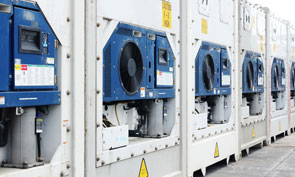
On virtually every major trade route in the world, you will find a disparity between the amount of refrigerated and non-refrigerated cargo travelling in either direction. Trade between China and North America is a case in point, with vastly more refrigerated cargo, such as food and pharmaceuticals, travelling to China than the amount making the return journey. This imbalance leaves intermodal shippers with a problem – how to get the refrigerated containers (known as reefers) back to where they are needed without incurring significant repositioning costs. Maersk alone estimates* it spends US$1 billion shipping empty containers around the world every year.
The obvious solution is the non-operating reefer (NOR). Carriers sell the space in these containers to importers and exporters at an attractively discounted rate compared to what they would pay for a standard dry container. This represents a great opportunity to reduce your logistics costs and help shippers operate in a more sustainable way, reducing the carbon impact of shipping empty containers around the world. While this solution seems simple, there are a number of factors you have to take into account, and these require the expert assistance of a specialist cargo protection partner.
Reefers are significantly different from regular steel containers. Not only are they a different size internally, they don’t have any lashing and anchor points and are lined with more fragile materials such as aluminum and plastic. What’s more, they cost seven times as much to build and repair, so it is vital that your cargo is packed and secured in a way that not only avoids damage to your shipment but also avoids damaging the container. That’s why it is imperative that your logistics teams work with expert partners when packing and planning shipments in non-operative reefers.
Cordstrap are fully aware of the risks and pitfalls of using non-operative reefers. We can help your logistics teams understand exactly how to configure shipments so you can leverage the commercial benefits this discounted capacity can deliver. We have an unrivalled range of cargo protection solutions that will ensure that your cargo is completely protected and which your operatives can deploy quickly and efficiently, further reducing total cost of ownership.
Our expert teams can provide detailed advice on deploying our world-leading Moisture Control solutions to give optimal protection for your cargo. Operating reefer containers control temperature (keep temperature stable at a certain level) this de facto means that the level of relative humidity is also controlled, and no moisture control products are required. However, with non-operating reefers this is a different story and the potential for moisture damages are significant.
NORs are more susceptible to moisture damages due to the untreated surfaces. Our moisture control solution, to a certain extent, even provides protection against moisture damages (corrosion) to the NOR itself.
When protecting cargo within NOR containers, the fact that non-operating reefer containers have no lashing points at the top makes installing container desiccants challenging. For this reason, Cordstrap Moisture Control incorporates products that can be positioned within the reefer container without being dependent on top lashing points.
To find out how Cordstrap’s global network of cargo experts and trainers could help your logistics team take advantage of non-operating reefers, get in touch.
*https://www.economist.com/business/2016/09/10/profits-overboard
For expert advice on cargo securing solutions contact us now
Contact nowCordstrap have specialists in over 50 global locations
Providing physical insurance to the world’s major industries
Delivering cargo protection solutions